|
Chiloé Island
To Chiloé Island
The Pan-American Highway continues from Puerto Montt to Quellón, but does not have the characteristics of a highway, it is simply a partially paved and partially concreted road. I would reach Carretera Austral only after sailing to Chaitén on the mainland, from where El Amarillo –the real bikers' road starts again. Perhaps I would not be able to cycle the whole route, because the sailing from Villa O'Higgins to Candelario Mancilla and especially the other sailing across Laguna del Desierto were highly uncertain. In November, the boat sailing across Laguna del Desierto departed once a week, provided that at least 20 passengers wished to travel together. I hoped that I would be able to persuade someone along the way. Who knew?
The route to Pargua harbor was challenging. Due to the widening of the road, for 25 km there was no verge, so I had to keep on staring in the mirrors to avoid my involvement in anything. Thanks to this, I was able to jump into the ditch as a precaution when a truck overtook a bus and both drivers were striving hard just to stay on the road next to each other. The overtaking lasted for about a kilometer, the road meanwhile had narrowed and the truck driver somehow did not take me into account.

[Canal de Chacao] Five ferry boats like this shuttle between the mainland and Chiloé Island during the day

[Chacao] The boat unloads the cargo and moves to Chacau port to load cars for the return voyage to Pargua
The ferry was already in Pargua, so I immediately cycled on to it. The trip across Canal de Chacao takes about 20 minutes, five ferries ply this route, so the transport is smooth during the day. The transport of the bicycle including myself cost 1500 Pesos (about 3 USD). Traffic on Chiloé island was mild, in waves, mostly only the cars from the ferry. There were a few hills on the way. I arrived in Ancud, which is the largest city, without a problem by 3 p.m.
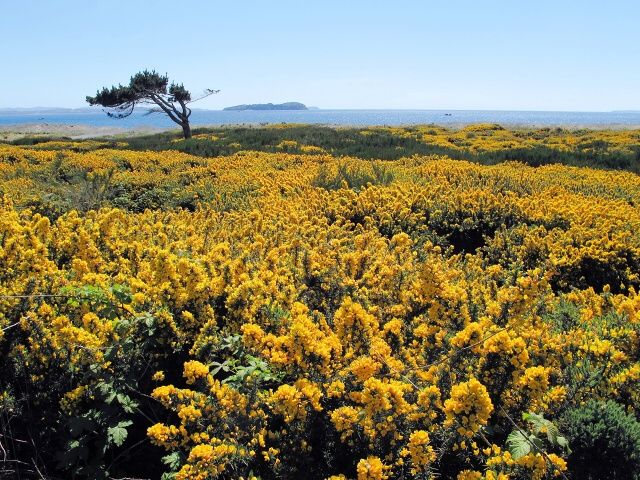
[Near Ancud] Typical yellow bushes create a pleasant ambience
Ancud
This had been a town with imposing architecture until 1960, when it was decimated by the earthquake. It had not yet recovered from the disaster when I saw it. The cathedral was still unfinished, it lacked the entrance part with the tower, but at least money was being collected for its completion. The guidebook claimed that the local Plaza de Armas was one of the most interesting in South America. I cannot confirm this, as it was surrounded by walls, with reconstruction being undertaken until the end of the year. Of course I went to the construction site, but no great glory or beauty were evident among the divine chaos.
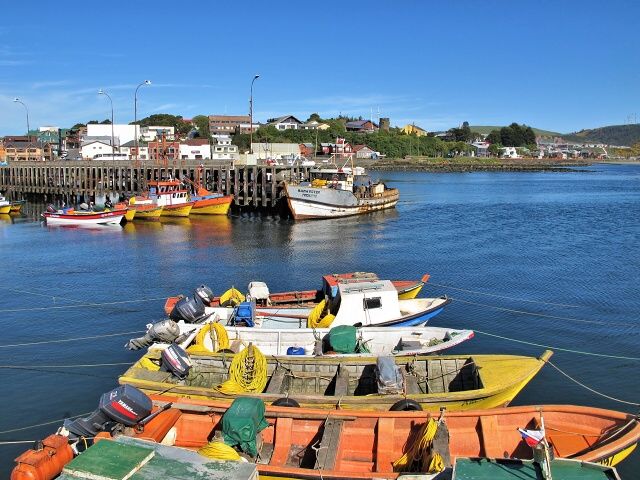
[Ancud] A view of town from the fishing port
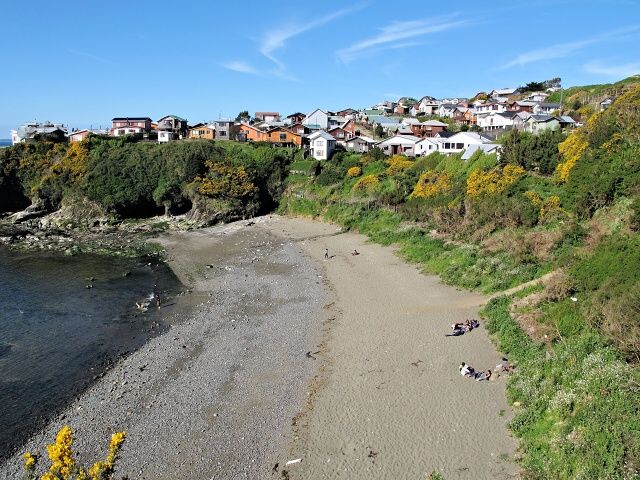
[Ancud] A town beach
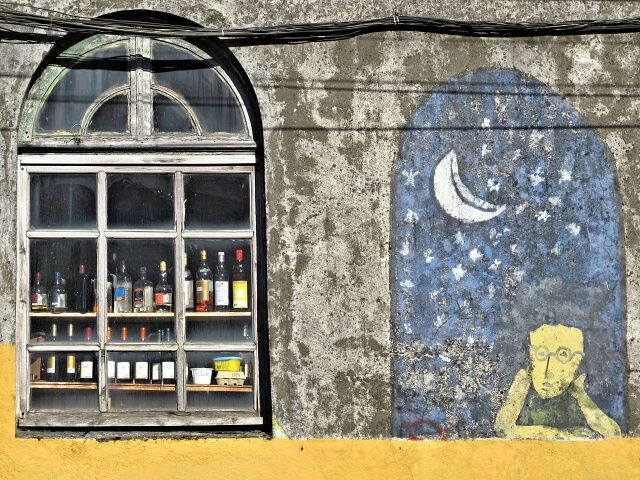
[Ancud] This man keeps everything close at hand
Enjoy Civilization while it Lasts
I had a few more days to sleep late, eat in pubs and buy whatever I desired in the supermercado. South of Chaitén this luxury would only be available sporadically. In the evening, I bought a bottle of Carmenere, a Chilean specialty - red wine with a flavor between Cabernet Sauvignon and Merlot. Wine prices were really affordable, at least for visitors, the locals seemed to have deeper pockets. Supermarkets usually sold one kind of red and white wine at 999 Pesos (4 USD) for a 0.7-l glass bottle which was quite drinkable (although, after the open bottle had been shaken along a 100-km bumpy road, it was hard to tell anyway). Then there was a wide range of wines priced between 1,500 and 2,500 Pesos for a 0.7-l bottle (3 to 5 USD) which is what I usually chose my wine from. It was best to ask for a cheap, good Chilean red wine, so the seller already knew what I wanted and the price was always less than 2,000 Pesos. Then there were also wines priced between 4,000 and 5,000 Pesos and even bottles costing over 10,000 Pesos (18 USD) appeared sporadically.
At dinner time, I went to a good local restaurant for a local specialty, curanto. This restaurant had been recommended to me by the tourist office. Curanto is a pile of food: 3 kinds of potatoes, chicken, smoked meat, sausage and especially a stack of several types of seafood. I was a little worried after the last culinary experience in a quality fish restaurant in Mexico, where the very tasty mussels subsequently demonstrated incompatibility with my digestion, though not dramatically, my stomach merely was overloaded and I did not vomit. Here, after four hours of digestion, nothing happened, so it seemed fine. I decided to have some sea creatures on the next day too, to enjoy myself to the full.

[Ancud] Curanto is the local specialty; I enjoyed reputedly the very best in the Kuranton Restaurant
She fell in Love with me at First Sight
Still in the streets of Ancud, a bitch of unknown breed decided to travel with me. I expected that she would follow me for about 3 km and then would be unable to keep up the pace. I greatly underestimated her commitment and the circumstances favorable to her efforts. The road was hilly, with steep descents and ascents where she always caught up with me. Repairs and widening were being undertaken to the road, so when I finally cycled away from her, she caught up to me while I was waiting for the green light at a partially closed road. And she even managed to drink from puddles along the road. The only rest she had was when I photographed churches along the way. After 40 km, I definitely shook her off, but still for another 2 km in the rearview mirror I saw a determined dot of devotion running after me on the verge.
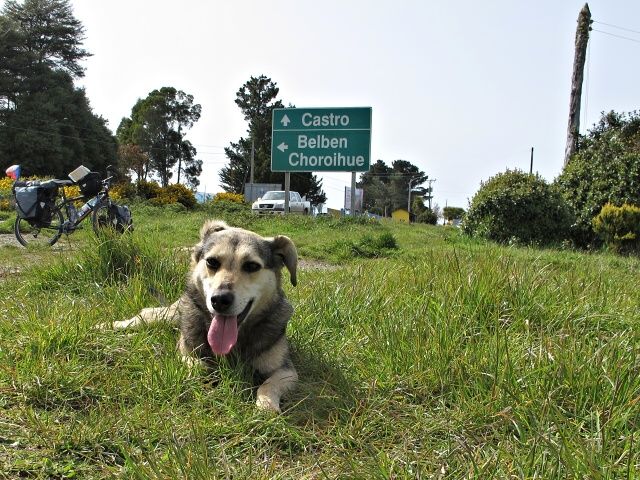
[Turning to Belben] My admirer is quite fit after 20 km of running….
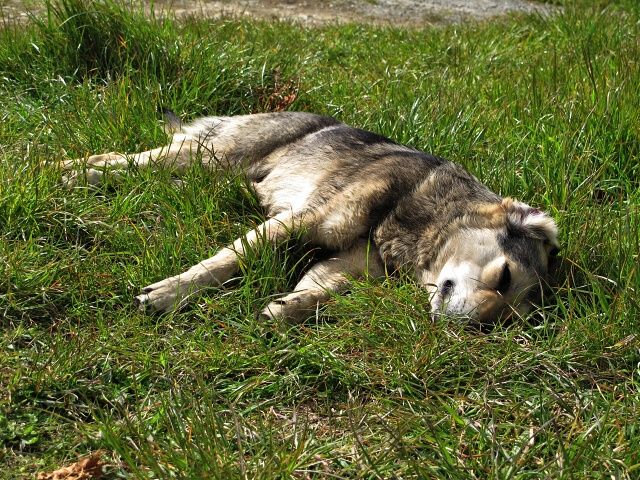
[Turning to Belben] ... but she had to have a short rest

[Mocopulli] The memorial to the Battle of Mocopulli
Wooden Churches
These are a highly valued specialty of Chiloé Island and tourist agencies organize trips to the most important of them. The highlight, however, is the Cathedral in Castro – or rather the Church of San Francisco – whose outer walls are covered in wooden shingles and corrugated sheet metal, with a wooden interior. The church is light, unlike most gloomy Chilean cathedrals, with a joyful atmosphere which encourages people to sit down. In the interior are several wooden statues carved in naturalistic – naivistic style. Look at the devil and you will understand what I mean. Other wooden churches have a distinctive architectural element in their rafters which extend downwards from the roof and are anchored in the ground.
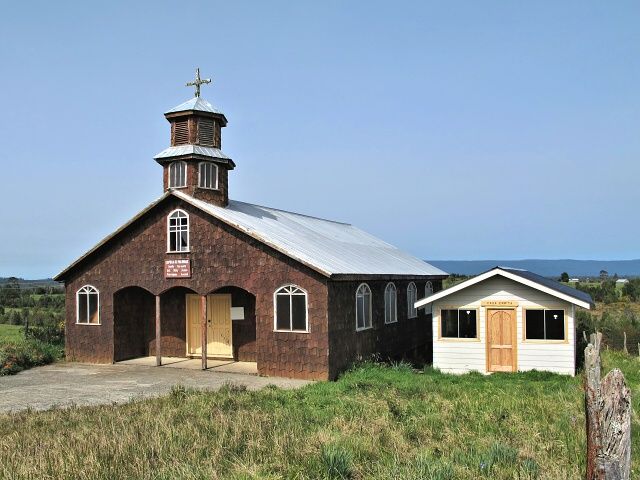
[Parroquia] Al Palomar chapel
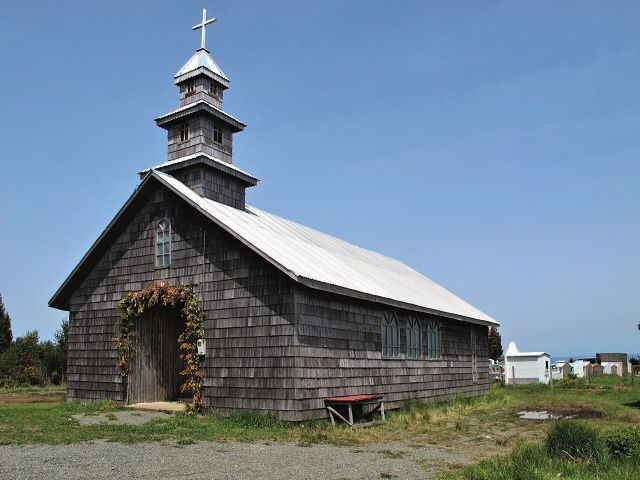
[Near Mocopulli] Another wooden church along the road

[Near Mocopulli] A beautiful two-storeyed turret

[Castro] Iglesia San Francisco, one of the most famous churches of Chiloé

[Castro] Iglesia San Francisco, part of the facade is covered with corrugated iron

[Castro] The Church of San Francisco – the wooden interior creates a very congenial atmosphere
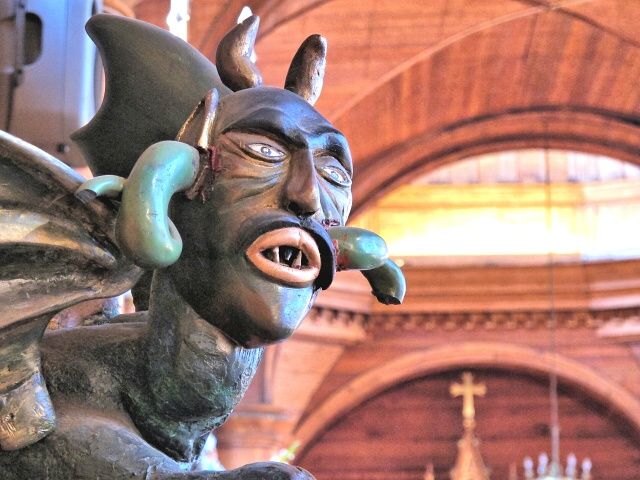
[Castro] The devil which Archangel Michael fought - a wooden statue in the Church of San Francisco
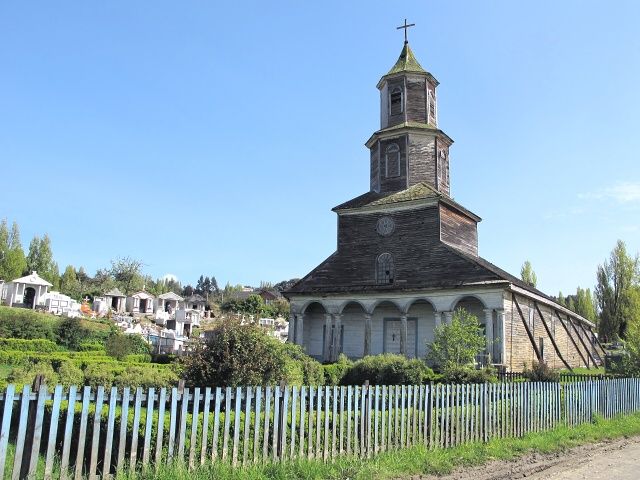
[Nercon] Church de Nuestra Seòora de Gracias, another very valued structure

[Chonchi] Again: one of the famous churches

[Chonchi] The church interior
Palafitos
Another specialty of Castro are palafitos. These houses are built on stilts. From the street, they look like normal houses, but at high tide you can sail right up to the entrance door. I really liked them, but was sure I could not persuade my wife to live in such a dwelling. And due to the changing high and low tides, the stilts often rot and so the whole building becomes very difficult to maintain.
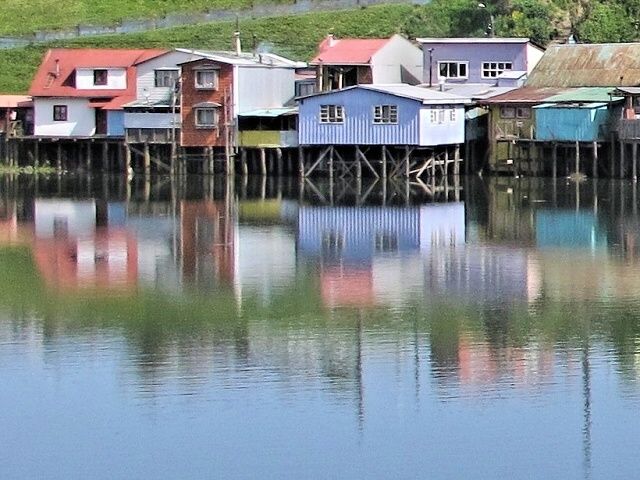
[Castro] Palafitos – these houses on stilts are listed buildings
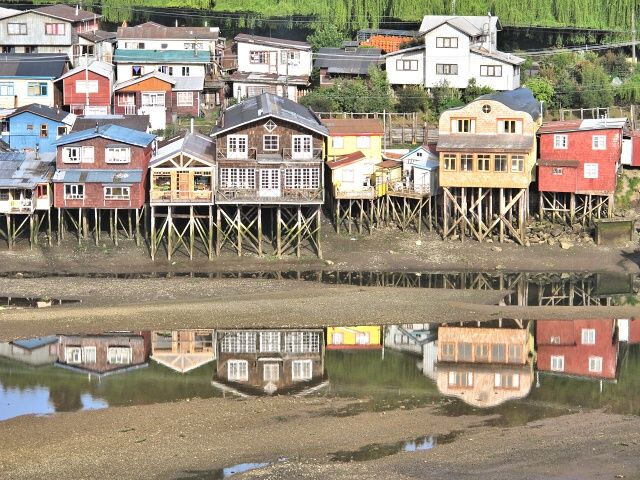
[Castro] Palafitos are situated in approx. 8 sites around the bay
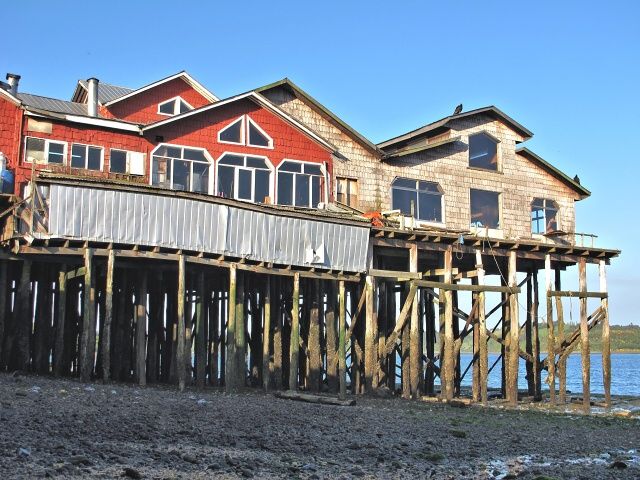
[Castro] A big palafito in the port is used as a restaurant
Towards the South of the island, the road became increasingly undulating. The hills stretched out and some were quite steep. I even used a 1:1.55 gearing (22 cogs in front, 34 cogs on the rear wheel). The weather deteriorated, occasionally there was a shower of rain, not sufficient for me to change into waterproof clothing. However, it was clear to me that the weather was changing and the exceptionally nice weather that had so far accompanied me had turned into the typical weather – overcast and rainy. No wonder, the end of October here corresponds to the end of April in Europe.
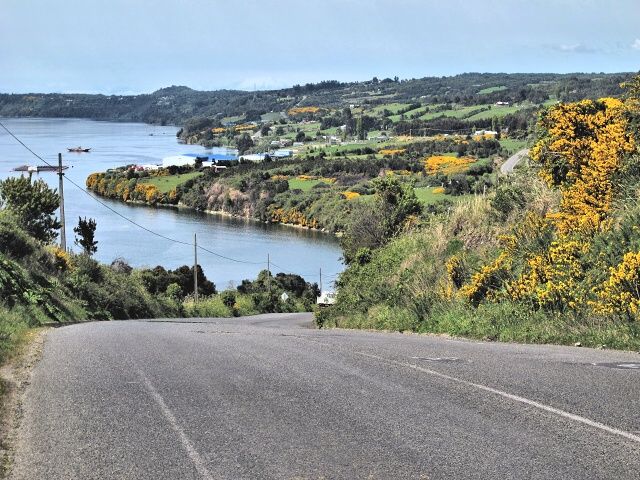
[Near Chonchi] The road going up and down around lakes and the sea
Back to the Mainland
I arrived in Quellón at 6 p.m. with plenty of time to spare. The ferry terminal is a few kilometers out of the town, so I cycled to the fishing port, which is near the center. In the shipping company's office, they told me not to cycle to the terminal, but that a bus would take me and my bike there at 10.30 p.m. I bought some non-perishable food items, which would be useful, tortillas instead of bread, as they last longer. In the restaurant, I ate cazuela de mariscos (literally, "a pot of shellfish") which is a bowl of soup made from mussels, potatoes and vegetable pieces. Cazuela is also made of chicken (ave) or beef (vacuna) and it was my favorite meal, especially during the day, as it gave me plenty of fluids in addition to the food.
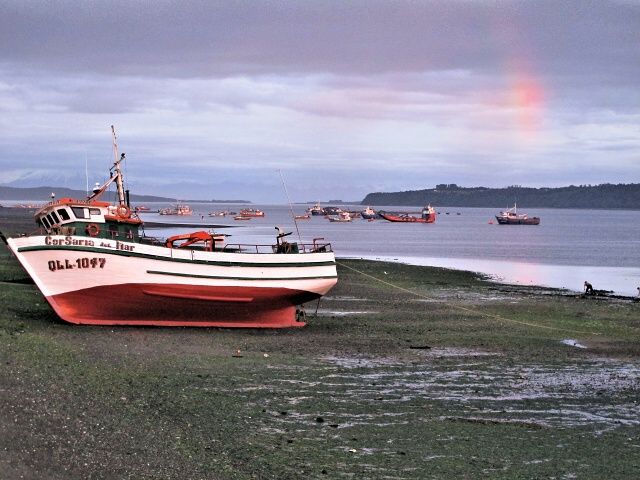
[Quellón] Almost at sunset, the rainbow appeared in the rain
Did I Oversleep and Miss the Arrival?
No other cyclist was there, but I chatted with an American who was going on walking tours in the national parks and a Spaniard who was traveling by bus and hitchhiking and who also wanted to go to the very South. Once on board, I lay down on a triple seat with folding armrests, which made a perfect bed when folded out – finally a reasonable shipping company! The lounge was pleasantly heated and I fell asleep almost immediately, oblivious of any departure. I woke up at 6.30 a.m., just as we were leaving some port. We had been due to arrive in Chaiten at 6 a.m. and so I was alarmed that I had probably overslept and failed to disembark. So I went to try to find out what port they were heading for, to be able to prepare an alternative route on land. People remained unperturbed, so I did not know where I stood. I took out my GPS and, in the rain on the stern deck, discovered that there had been a six-hour delay and that we had just left Quellón and would be in Chaiten after noon. So I had slept in peace, and then, in the pouring rain, stood and watched out for the mainland.
From the tourist map on the notice board, I realized that perhaps I could cycle from Puerte Montt directly on to Carretera Austral. All three shipping routes that were open in previous years only in January and February, according to the map, were now operating all the year round. But when I asked about it, a crew member told me that the information was not reliable, so I was not sure.
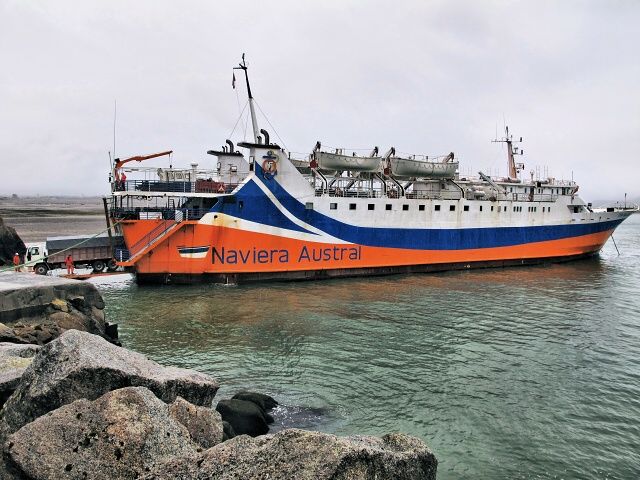
[Chaitén] We arrived on the mainland after a 6-hour delay



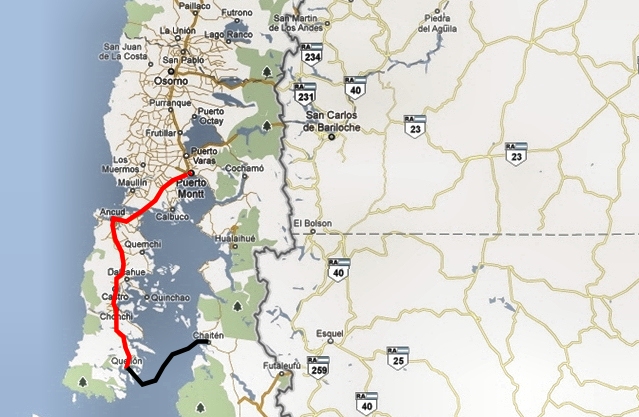
| 




































